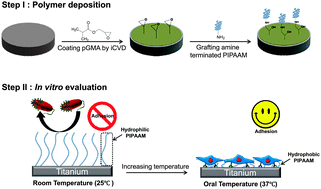Biofunctionalized titanium with anti-fouling resistance by grafting thermo-responsive polymer brushes for the prevention of peri-implantitis†
Abstract
In the last decade, titanium has been effectively used in the dental field for oral surgery as an implant material. However, disinfected Ti can be easily re-infected by the surrounding environment. Thus, a novel anti-fouling treatment for Ti implants is currently necessary. In this study, we designed an anti-fouling surface comprised of poly N-isopropylacylamide (PIPAAM) grafted Ti by introducing poly glycidyl methacrylate (pGMA) coating via an initiated chemical vapor deposition (iCVD) system to prevent bacterial infection. The results indicate that pristine Ti was well coated with pGMA with a film thickness of approximately 60 nm and uniformly grafted with PIPAAM. The bacteria were effectively detached after rinsing with a buffer solution at room temperature, while hADSCs were well attached on the surface treated Ti surface at oral temperature. All tests clearly confirm that our strategy may be a useful means of imparting anti-fouling characteristics to Ti in order to prevent bacterial adhesion and resultant peri-implantitis.


 Please wait while we load your content...
Please wait while we load your content...